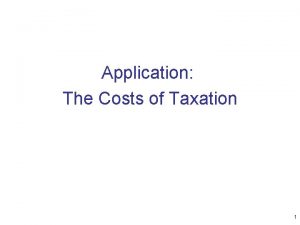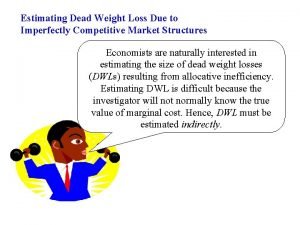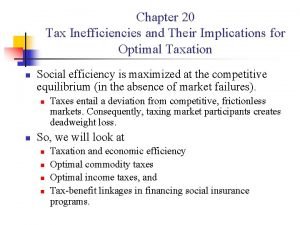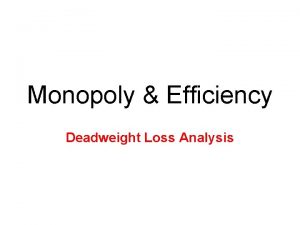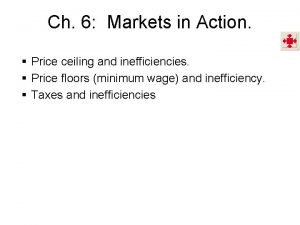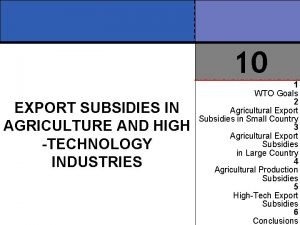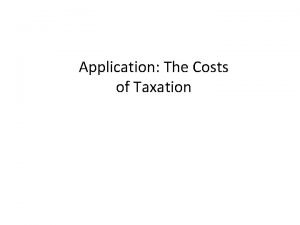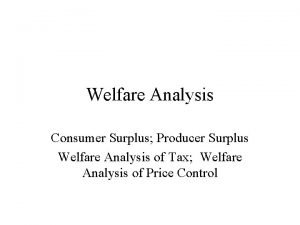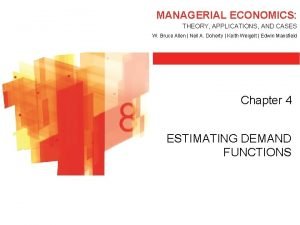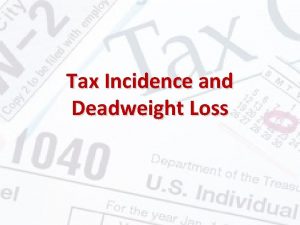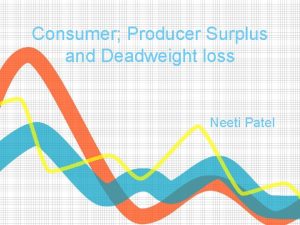APPLICATIONS DEADWEIGHT LOSS ETP Economics 101 DEADWEIGHT LOSS

































- Slides: 33

APPLICATIONS: DEADWEIGHT LOSS ETP Economics 101

DEADWEIGHT LOSS Changes in Welfare A deadweight loss is the fall in total surplus that results from a market distortion, such as government regulations on prices and tax.

PRICE REGULATION Case 1: Rent control Case 2: Minimum wage

Price ($ per month) RENT CONTROL: EQUILIBRIUM 1100 b 1000 900 0 supply equilibrium excess demand 290 300 demand 310 Quantity (Thousand units a month)

Rent Control: Surpluses Price ($ per month) Consumer surplus gain = cfeg Consumer surplus loss = dgb Producer surplus loss = cfeg + geb Deadweight loss=dgb+geb d 1100 1000 c 900 f b g supply e demand 0 290 300 310 Quantity (Thousand units a month)

Wage ($ per hour) MINIMUM WAGE: EQUILIBRIUM a excess supply 4. 20 b 4. 00 equilibrium c 0 demand 8 10 11 Quantity (Billion worker-hours a week)

Wage ($ per hour) Minimum Wage: Surpluses seller (employee) surplus gain = fdge seller (employee) surplus loss = ghb buyer (employer) surplus loss = fdge + egb Deadweight loss=ghb+egb a 4. 20 4. 00 f d supply e b g h c 0 demand 8 10 11 Quantity (Billion worker-hours a week)

The Deadweight Loss of Taxation Tax on a good l Levied on buyers • Demand curve shifts downward by the size of tax l Levied on sellers • Supply curve shifts upward by the size of tax l Same outcome: price wedge • Price paid by buyers – rises • Price received by sellers – falls • Lower quantity sold 8

The Deadweight Loss of Taxation Tax burden Distributed between producers and consumers l Determined by elasticities of supply and demand l Market for the good - smaller 9

The effects of a tax Price Supply Price buyers pay Price without tax Size of tax Price sellers receive Demand 0 Quantity with tax Quantity without tax Quantity A tax on a good places a wedge between the price that buyers pay and the price that sellers receive. The quantity of the good sold falls. 10

TAX WEDGE A tax places a wedge between the price buyers pay and the price sellers receive. Because of this tax wedge, the quantity sold falls below the level that would be sold without a tax. The size of the market for that good shrinks.

THE DEADWEIGHT LOSS OF TAXATION How a tax affects market participants Gains and losses from a tax on a good consumer surplus Sellers: producer surplus Government: total tax revenue Tax times quantity sold Public benefit from the tax 12 Buyers:

FIGURE 2 TAX REVENUE Price Supply Price buyers pay Size of tax (T) Tax revenue (T × Q) Price sellers receive Demand Quantity sold (Q) 0 Quantity with tax Quantity without tax Quantity Copyright © 2004 South-Western

HOW A TAX AFFECTS WELFARE Price buyers pay =PB Price without=P 1 tax Price =PS sellers receive Supply A B C E D F 0 Consumer Surplus Producer Surplus Tax Revenue Total Surplus Demand Q 2 Q 1 A tax on a good reduces consumer surplus (by the area B + C) and producer surplus (by the area D + E). Because the fall in producer and consumer surplus exceeds tax revenue (area B + D), the tax is said to impose a deadweight loss (area C + E). Quantity Without Tax With Tax Change A+B+C D+E+F None A+B+C+D+E+F A F B+D A+B+D+F -(B+C) -(D+E) +(B+D) -(C+E) The area C + E shows the fall in total surplus and is the deadweight loss of the tax 14

THE DEADWEIGHT LOSS OF TAXATION Losses of surplus to buyers and sellers from a tax the revenue raised by the government Deadweight loss Fall in total surplus that results from a market distortion, such as a tax Taxes distort incentives Markets allocate resources inefficiently 15 Exceed

DETERMINANTS OF DEADWEIGHT LOSS What determines whether the deadweight loss from a tax is large or small? The magnitude of the deadweight loss depends on how much the quantity supplied and quantity demanded respond to changes in the price. That, in turn, depends on the price elasticities of supply and demand.

DETERMINANTS OF DEADWEIGHT LOSS The greater the elasticities of demand supply: the larger will be the decline in equilibrium quantity and, the greater the deadweight loss of a tax.

FIGURE 5 TAX DISTORTIONS AND ELASTICITIES (a) Inelastic Supply Price Supply When supply is relatively inelastic, the deadweight loss of a tax is small. Size of tax Demand 0 Quantity Copyright © 2004 South-Western

FIGURE 5 TAX DISTORTIONS AND ELASTICITIES (b) Elastic Supply Price When supply is relatively elastic, the deadweight loss of a tax is large. Size of tax Supply Demand 0 Quantity Copyright © 2004 South-Western

FIGURE 5 TAX DISTORTIONS AND ELASTICITIES (c) Inelastic Demand Price Supply Size of tax When demand is relatively inelastic, the deadweight loss of a tax is small. Demand 0 Quantity Copyright © 2004 South-Western

FIGURE 5 TAX DISTORTIONS AND ELASTICITIES (d) Elastic Demand Price Supply Size of tax Demand When demand is relatively elastic, the deadweight loss of a tax is large. 0 Quantity Copyright © 2004 South-Western

DEADWEIGHT LOSS AND TAX RATE With each increase in the tax rate, the deadweight loss of the tax rises even more rapidly than the size of the tax.

THE DEADWEIGHT LOSS DEBATE 40% labor tax - Small or large deadweight loss? Labor supply - fairly inelastic Almost vertical Tax on labor - small deadweight loss Labor supply - more elastic Tax on labor – greater deadweight loss 23

TAX REVENUE AND TAX RATE For the small tax, tax revenue is small. As the size of the tax rises, tax revenue grows. But as the size of the tax continues to rise, tax revenue falls because the higher tax reduces the size of the market.

FIGURE 6 DEADWEIGHT LOSS AND TAX REVENUE FROM THREE TAXES OF DIFFERENT SIZES (a) Small Tax Price Deadweight loss Supply PB Tax revenue PS Demand 0 Q 2 Q 1 Quantity Copyright © 2004 South-Western

FIGURE 6 DEADWEIGHT LOSS AND TAX REVENUE FROM THREE TAXES OF DIFFERENT SIZES (b) Medium Tax Price Deadweight loss PB Supply Tax revenue PS 0 Demand Q 2 Q 1 Quantity Copyright © 2004 South-Western

FIGURE 6 DEADWEIGHT LOSS AND TAX REVENUE FROM THREE TAXES OF DIFFERENT SIZES (c) Large Tax Price PB Tax revenue Deadweight loss Supply Demand PS 0 Q 2 Q 1 Quantity Copyright © 2004 South-Western

FIGURE 7 HOW DEADWEIGHT LOSS AND TAX REVENUE VARY WITH THE SIZE OF A TAX Deadweight Loss 0 Tax Size Copyright © 2004 South-Western

FIGURE 7 HOW DEADWEIGHT LOSS AND TAX REVENUE VARY WITH THE SIZE OF A TAX Tax Revenue 0 Tax Size Copyright © 2004 South-Western

DEADWEIGHT LOSS & TAX REVENUE AS TAXES VARY As the tax increases loss increases Even more rapidly than the size of the tax Tax revenue Increases initially Then decreases Higher tax – drastically reduces the size of the market 30 Deadweight

LAFFER CURVE AND SUPPLY-SIDE ECONOMICS The Laffer curve depicts the relationship between tax rates and tax revenue. Supply-side economics refers to the views of Reagan and Laffer who proposed that a tax cut would induce more people to work and thereby have the potential to increase tax revenues.

THE LAFFER CURVE AND SUPPLY-SIDE ECONOMICS 1974, economist Arthur Laffer curve Supply-side economics Tax rates were so high Reducing them would actually raise tax revenue Ronald Reagan - ran for president in 1980 From experience in film industry High tax rates - caused less work Low tax rates - caused more work 32

THE LAFFER CURVE AND SUPPLY-SIDE ECONOMICS Ronald Reagan - ran for president in 1980 Argument Taxes were so high that they were discouraging hard work Lower taxes would give people the proper incentive to work Raise economic well-being Perhaps increase tax revenue Economists continue to debate Laffer’s argument General lesson: Change in tax revenue from a tax change Depends on how the tax change affects people’s behavior 33
 Etp presentation
Etp presentation Etp pharmacy
Etp pharmacy California etp program
California etp program Deadweight loss tax
Deadweight loss tax Positive externality deadweight loss
Positive externality deadweight loss Dead weight loss calculation
Dead weight loss calculation Deadweight loss formula
Deadweight loss formula Deadweight loss in a monopoly
Deadweight loss in a monopoly Perfectly price discriminating monopoly
Perfectly price discriminating monopoly Allocative efficiency monopoly
Allocative efficiency monopoly Binding price floor
Binding price floor 2222012
2222012 Subsidy deadweight loss
Subsidy deadweight loss Health externalities
Health externalities Deadweight loss
Deadweight loss Positive externality deadweight loss
Positive externality deadweight loss Monopoly graph deadweight loss
Monopoly graph deadweight loss X-inefficiency
X-inefficiency Producer
Producer Tariffs deadweight loss
Tariffs deadweight loss Hair loss 101
Hair loss 101 Managerial economics: theory, applications, and cases
Managerial economics: theory, applications, and cases Managerial economics applications strategy and tactics
Managerial economics applications strategy and tactics Difference between normal loss and abnormal loss
Difference between normal loss and abnormal loss Maastricht university school of business and economics
Maastricht university school of business and economics Econ213
Econ213 Raoult's law physical pharmacy
Raoult's law physical pharmacy Application of conductometry
Application of conductometry Web based mapping
Web based mapping Distillation application
Distillation application Terahertz spectroscopy principles and applications
Terahertz spectroscopy principles and applications Lan applications
Lan applications Application of weighted graph
Application of weighted graph Dimensional analysis and its applications
Dimensional analysis and its applications



